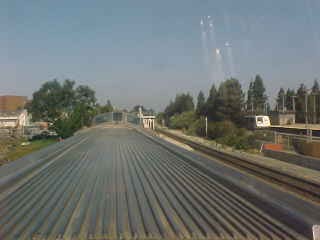
Steve Grande, owner of Trainweb.com, asked me to cover the Trains Unlimited Tours' Domes to the Feather River Railroad Days. The trip, in private cars on the rear of the California Zephyr, was over Donner Pass to Sparks, where we would be bussed to Portola the next day for the Western Pacific Railroad Museum's Feather River Railroad Days. The plan was to return the following day to Oakland and I would leave the group at Sacramento, taking the San Joaquin and Amtrak Thruway Bus home.
Emeryville 8/26/2005 The group met at the Amtrak Emeryville station for the private car trip to Sparks, Nevada. I came off Capitol Corridor Train 522 from Oakland this morning and found Bill Parks, our tour guide, talking with some other passengers and quickly introduced myself, which started the first of many excellent conversations. We all moved our luggage over by the elevator where it would be loaded before by our passengers. The station agent announced an hour's delay to our California Zephyr departure and we learned it was a problem with the Amtrak dining car. That meant I could railfan from the pedestrian bridge while I waited.

A Union Pacific freight caught me by surprise but it stopped and I found Western Rails Incorporated SW1200 3528, ex. BNSF 3528, exx. Burlington Northern 174, nee Northern Pacific 174:2 built by Electro-Motive Division in 1958.
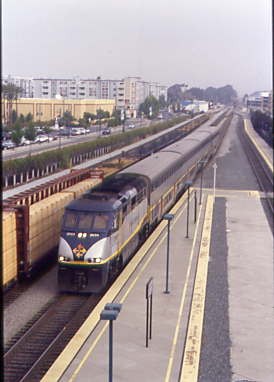
Capitol Corridor Train 527 from Auburn.

BNSF 5743 next passed through Emeryville.
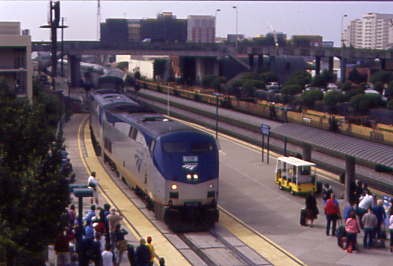
The California Zephyr arrived at 10:10 AM with a consist of P42DCs 138 and 61, baggage 1353, transition 39007, sleepers 32095 and 32026, diner 38014, lounge 33000, coaches 34000, 34001 and 35009, PPCX 800392 Santa Fe dome 503 "Plaza Santa Fe" and dome-observation car PPCX 800190 "Silver Lariat".
Plaza Santa Fe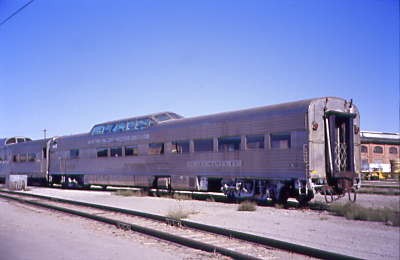
Santa Fe Pleasure Dome-Turquoise Room 503 "Plaza Santa Fe", built by Pullman Company in 1950 for service on the Super Chief operating between Los Angeles and Chicago and designed for deep cushioned comfort. It features a glass- domed observation deck with large swivelling chairs. Downstairs are two lounge areas with a full bar and an elegant dining room. Every seat is adjacent to a picture window to insure that all passengers have an unparalleled view of the world as it quietly glides by.
This is one of six Pleasure Domes featuring the famous Turquoise dining room, a favourite of film stars and other notables. These were coupled directly behind the new diners and the Turquoise Room located in the forward part of the Pleasure domes was served from the dining car. During peak travel periods, it served as extra dining space for twelve. At other times, the Turquoise room was available for private luncheon or dinner parties. Many an evening the Turquoise rooms served as private cocktail lounges for Hollywood stars and their guests or captains of Fortune 500 companies.
The dome seating was unique to these dome cars, on each side in the center of the dome was four swivelling parlour seats revolving a full 360 degrees. At the front of the dome, and the rear of the dome on each side of the aisle, was a pair of seats. The two pairs of seats at the rear faced rearward, an unusual arrangement not found on any other short domes.
The car was acquired by Amtrak in 1971 and re-numbered 9353. California Rail Tours, who added the car's originally intended Plaza Santa Fe name, has owned this dome car since 1986.
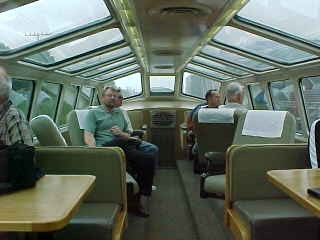
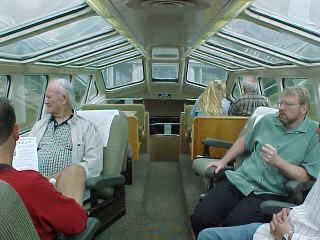
The dome of this beautiful car.
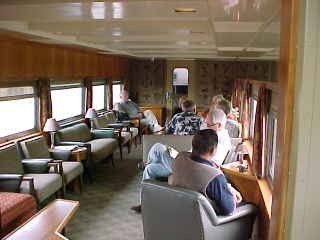
The forward lounge.
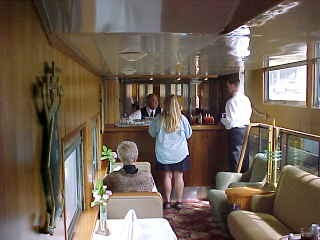
The lower bounge and bar under the dome.

The passageway along the lower lounge.
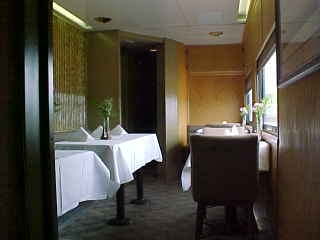
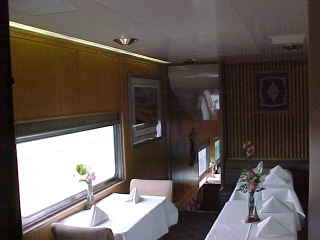
The Turquoise Room.
Silver Lariat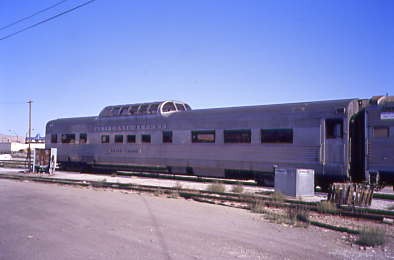
"Silver Lariat" was built by the Budd Company in 1948 for the famous California Zephyr which operated between Chicago and San Francisco. Following that career, it wandered the country as Amtrak 9452 until 1985 then the present owners completely overhauled it mechanically and renovated the interior. The car features an observation dome seating 24 for viewing the passing scenery, complete with lounge tables. Very comfortable reclining coach seats on the main level seats 44, with pillows and blankets available for overnight.
The car can carry 68 day passengers and 40 overnight and dning tables are available on the lower level. The galley provides beverage and full gourmet multi-course dining service. The car is Amtrak compatible, including push-pull service and features an on-board diesel generator, TV/VCR, including public address, compact disc player and radio tuner. It is now owned and operated by California Zephyr Railcar Charters, headquartered in Costa Mesa, California.
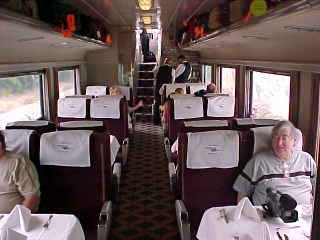
Forward coach section.
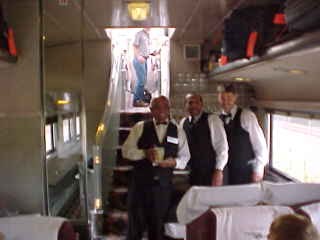
Bert Dorland, William Hall and Cliff McDaniel, "Silver Lariat" staff.
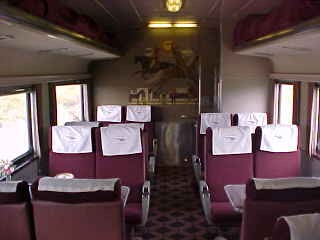

The rear coach section.

Passageway under the dome.
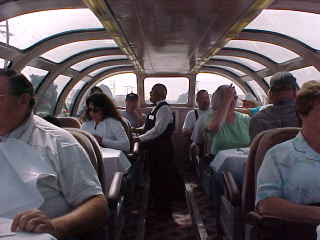

The dome.
Domes to the Feather River Railroad Days Excursion 8/26/2005I chose a seat in the dome of "Plaza Santa Fe" and we departed Emeryville at 10:22 AM {9:15 AM}.

Our train passed the BART Richmond station.
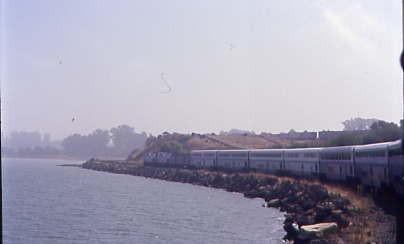
Paralelling San Pablo Bay at Pinole.
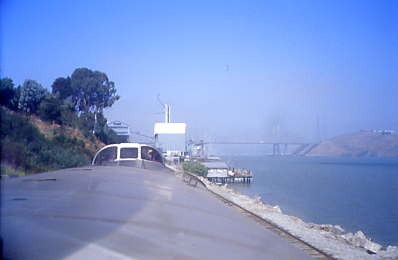
Looking back at the Interstate 80 bridges at Crockett.
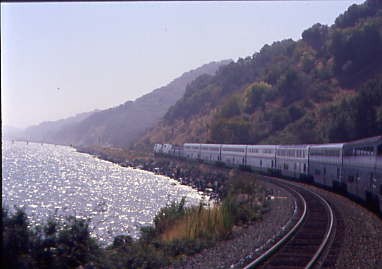
Running along the Carquinez Straits. We stopped at Martinez to pick up two passengers for our tour.
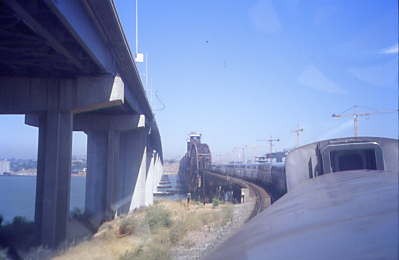
Curving onto the great railroad bridge at Martinez.
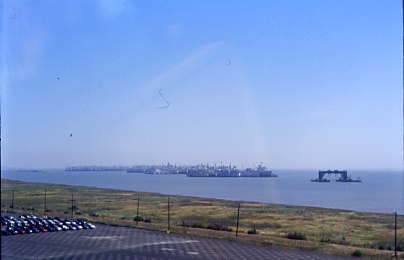
The Mothball Fleet of the United States Navy.
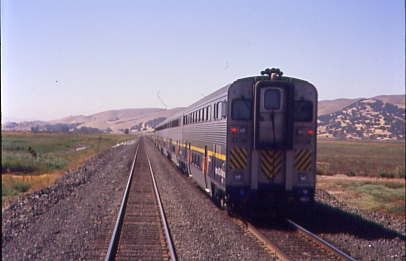
We stopped at Bahia to wait for Capitol Corridor Train 533 to proceed west towards the Bay area.
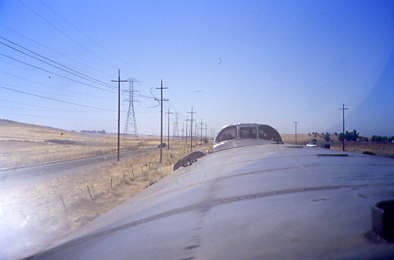
The "Silver Lariat" dome car behind us as we passed through Cannon.

We travelled to our next station stop of Davis.
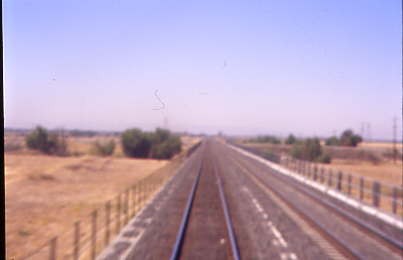
The California Zephyr crossed the Yolo Bypass on the way to Sacramento, where we departed Sacramento at 12:41 PM {11:14 AM} then continued east past the former McCullen Air Force Base and on to the J.R. Davis Yard in Roseville where we stopped at Roseville before starting the climb into the Sierra Foothills. It was then time to explore the private car in which I was happily esconced.
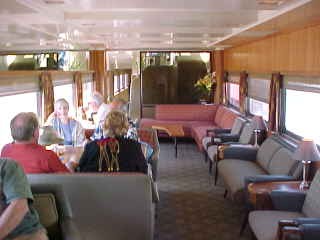
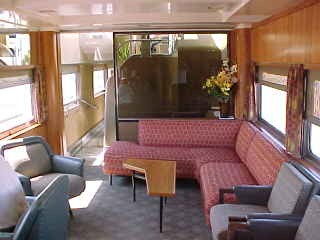
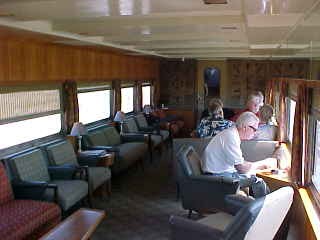
Passengers enjoying the forward lounge of "Plaza Santa Fe".
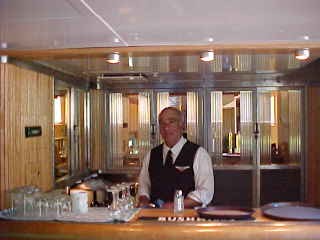
Bartender Norman Bardley.
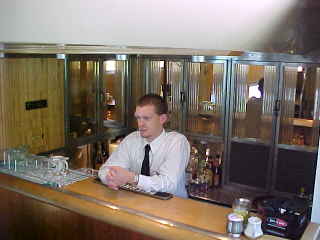
Wayne Yetter, Jr., car owner and bartender, waiting to serve.

I had lunch in the Turquoise Room with Ed Martin of San Francisco.
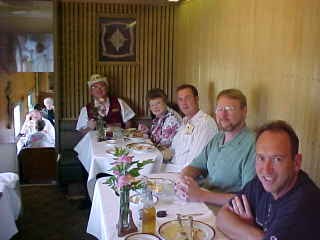
Passengers enjoying lunch in the Turquoise Room.

Our hip-shaking Waiter William Hall, who was excellent and entertaining.
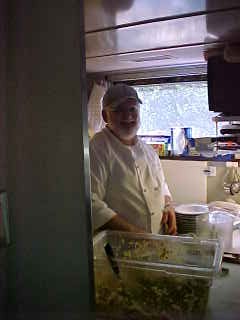
Steve, our wonderful chef, who cooked all our excellent meals in the small galley of the "Silver Lariat".
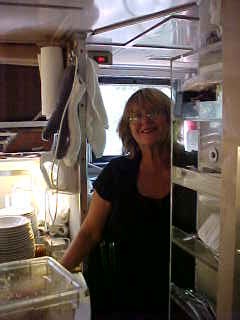
Lelia, our wonderful Chef Assistant, who was preparing the desserts.

The kachina artwork on the forward end wall.
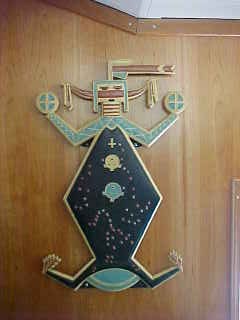
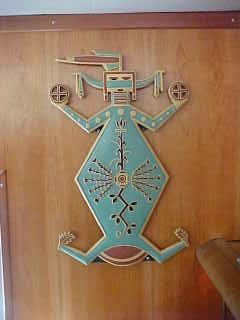
The more I explore, the more items I found.

The author enjoying "Plaza Santa Fe" inside a tunnel.
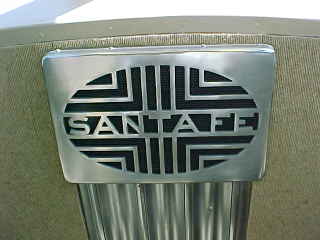
The Santa Fe grillwork in the front of the dome. We climbed into the pine trees before overtaking Union Pacific 5876 East and arrived at Colfax, departing there at 3:58 PM {12:26 PM} and starting the true climb over the Sierra Nevada Mountains.
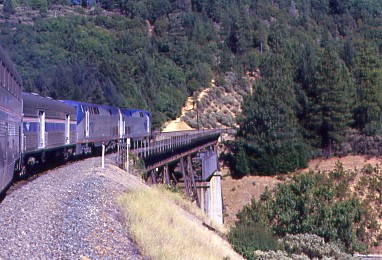
The California Zephyr crossed Long Ravine before we rounded Cape Horn on Donner Pass and kept ascending, passing through Gold Run, Alta and Blue Canon.

View from the dome below Emigrant Gap.
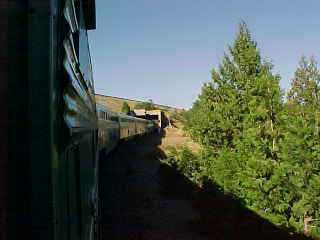

The Gap of the Yuba River for which Yuba Gap is named.
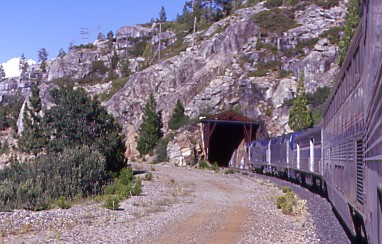
Our passage through Yuba Gap.
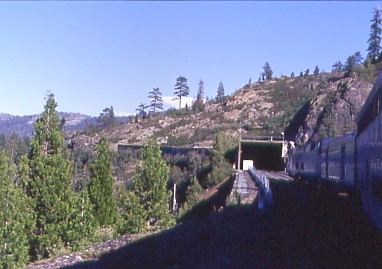
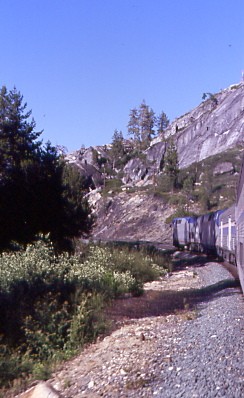
Climbing between Yuba Gap and Norden. We ran through Soda Springs and Norden before entering the "Big Hole", also known as the Donner Pass Summit Tunnel then exited and minutes later, rounded Sanford Curve before we ran down Coldstream Canyon to Truckee. After a double stop, we departed Truckee at 6:22 PM {2:43 PM} on the way to Reno in the fading light of day and followed the Truckee River Canyon east to Verdi before passing through the ever-expanding greater Reno metropolitan area.
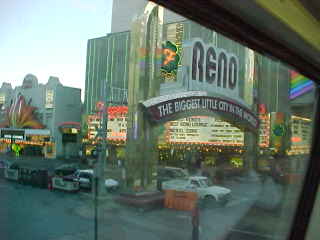
The Reno sign that reads "Biggest Little City in the World". This might be the last time I see the sign lit as it would not be able to be seen from the train when the California Zephyr moves to the new route through the trench.
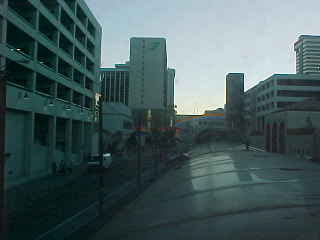
The California Zephyr during its station stop at Reno, from which we departed at 7:33 PM {3:58 PM} and journeyed the last few miles to Sparks.
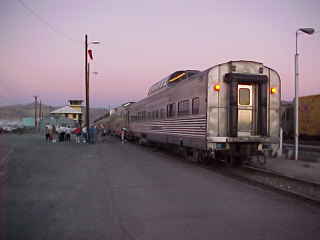
We arrived at Sparks at 7:42 PM and after I detrained, a couple of photographs were in order.

"Silver Lariat".
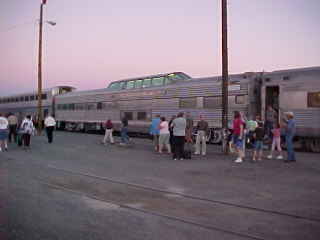
"Plaza Santa Fe".
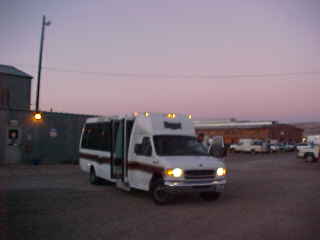
The shuttle van that took all of us to the John Ascuaga Nugget Hotel. I went straight to Room 1711 and had to go down to the front desk to have my phone turned on for a dollar a call. I walked over to In and Out Burger for dinner then returned to my room to call home. My luggage was delivered to my room and I recharged the digital camera batteries before calling it a night.
Sparks 8/27/2005Up early, I visited a bagel counter for a maple bar and some freshly-squeezed orange juice then played a few slots before walking over to the Century 14 Theater to check show times for later this afternoon. I watched some CNN news and the Weather Channel to see where Hurricane Katrina was. At 9:00 AM, I walked out to board the bus for the trip to Portola Railroad Days and it took about fifty minutes to get there.
Portola 8/27/2005After arrival, I walked across the Gulling Street bridge of the Feather River to a drug store for some supplies.
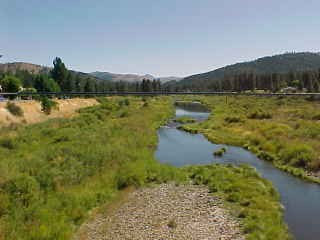
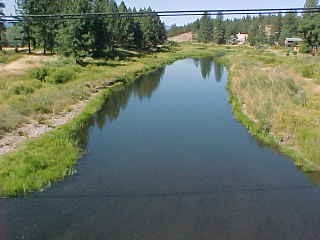
The Middle Fork of the Feather River as seen from the bridge.

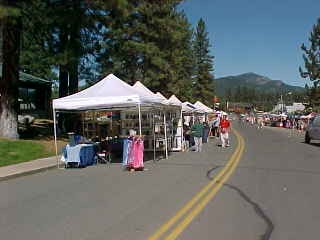
Street vendors in booths on South Gulling Street.
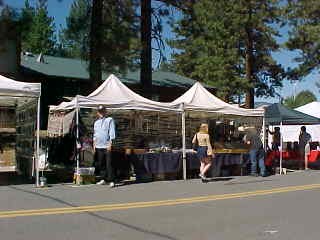
One of our Trains Unlimited passengers at the booth.
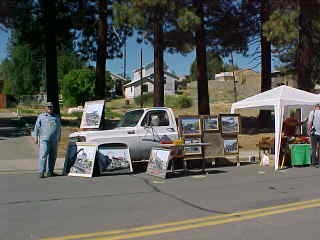
Kenneth Roller, local Portola train artist.
Portola 23rd Annual Railroad Days Festival Golden Spike Parade "Railroad Ties"At 11:00 AM, every horn that could be blown at the Portola Railroad Museum, was blown to signal the start of the Golden Spike parade.
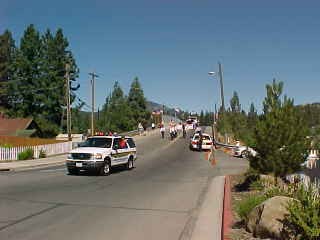

The local sheriff made sure the parade route was clear.
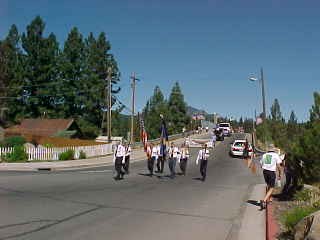
The Golden Spike Parade flag bearers.
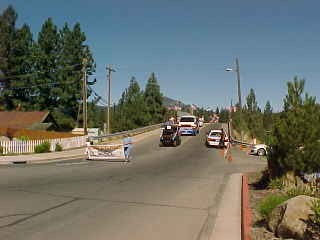
The Golden Spike Parade banner carriers.
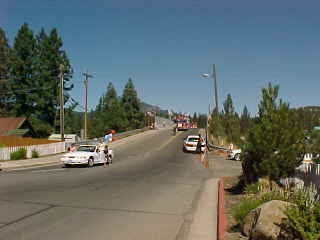
The 2005 Grand Marshals Willie Lawrence and Betty Marshall.
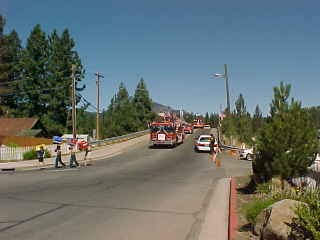
Fire truck with Explorer Scouts.
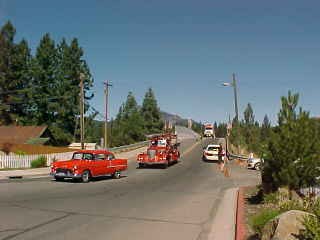
The first of the fantastic restored cars.
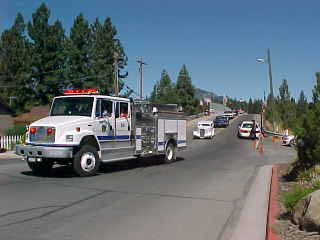
A Portola fire truck.
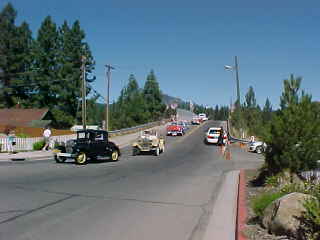
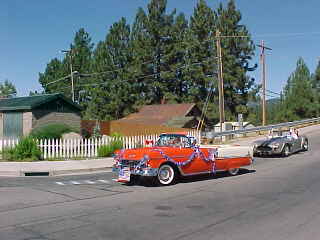

More classic autos.
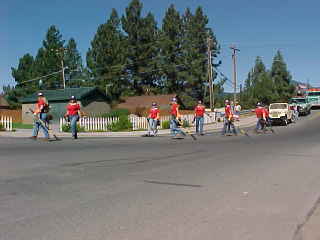
Sierra Power Company Hot Stix Drill Team from Reno, Nevada.
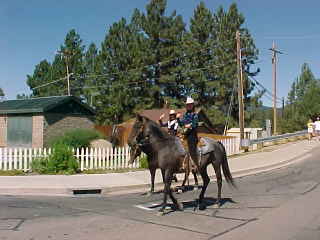
You cannot have a parade without horses.
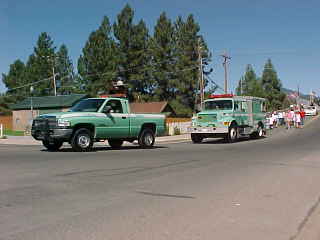

I called Let's Talk Trains and told about Portola Railroad Days then walked towards the Portola Railroad Museum.
The Portola Railroad Museum 8/27/2005In 1983, the Feather River Rail Society was formed with the goal of preserving the legacy of the Western Pacific Railroad. The Union Pacific graciously donated several pieces of equipment and granted use of the former WP locomotive facility in the City of Portola to the society. This 37-acre site includes a 16,000 square foot diesel shop in active use from 1954 until 1974 and two-and-a-half miles of track. This facility became home to what is now the Portola Railroad Museum.
Our collection includes locomotives, rolling stock, an extensive gathering of corporate records, paperwork, artifacts and historic photos and films. Visitors to the museum soon discover that this is a hands-on facility where they are encouraged to climb into the cabs of locomotives, sit in the engineer's seats and browse through the rolling stock on display. Visitors can get up close to our restoration projects in the working shop. There is an exhibit room and various railroad-related displays throughout the building.
The FRRS is a not-for-profit, 501(c)3 volunteer organization that does not receive any government funding. The continued existence of this museum and archives depends upon revenue gathered from memberships, donations, fundraising, admissions and store sales. Please help support our mission to preserve and protect the legacy of the Western Pacific and its people. You are invited to become a member of the FRRS and join our team of volunteers here at the museum.
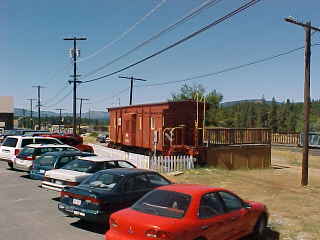
Western Pacific wooden caboose 645 built by the railroad in 1943 converted from Pullman boxcar, now serving in another capacity. From there it was an easy walk to the museum.
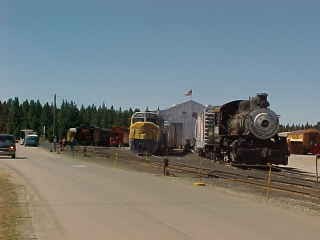
The view looking into the Portola Railroad Museum.
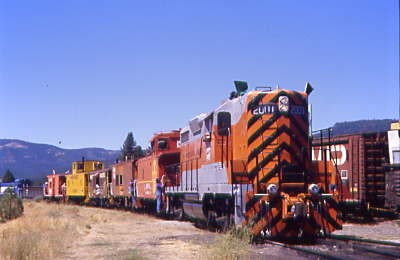
I walked to the excursion train that would take me around the balloon track and boarded Southern Pacific Bay window caboose 4706. After a nice ride and getting a feel for the museum again, I went to start my tour of the grounds.
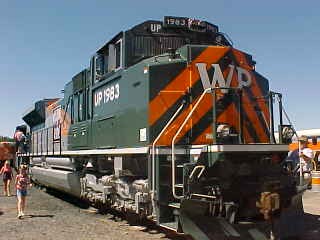

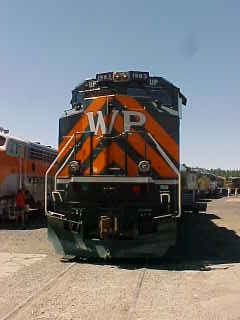
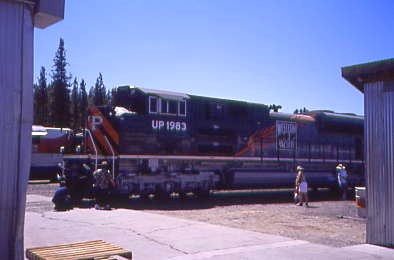
Union Pacific SD70ACe 1983, the Western Pacific heritage unit, a guest at the 2005 Portola Railroad Days. Western Pacific was absorbed by Union Pacific in 1983, hence the number.
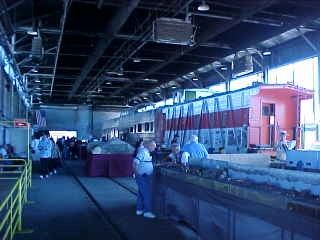
The interior of the shop building.

Interior of the newly-acquired California Zephyr Vista Dome coach 4714 "Silver Lodge" built by Budd Company in 1948.
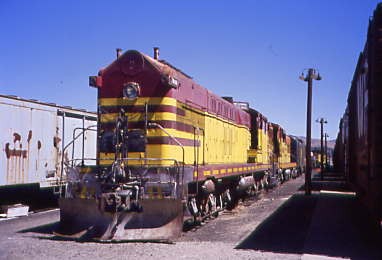
Oregon Northwestern AS-616 3, nee Southern Pacific 5274, built by Baldwin in 1952 and donated to the museum in 1990.
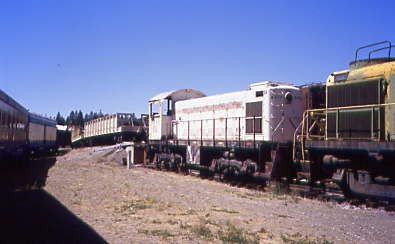
An old friend from Stockton, Stockton Terminal and Eastern S1 506, nee Western Pacific 506 built by American Locomotive Company in 1942. The Stockton Terminal and Eastern is a small railroad that serves a variety of industries on the east side of the city of Stockton. For most of its history, the ST&E was barely able to make a dime. It needed only one steam locomotive (itself a working museum piece built in 1864) to serve its few industries and was often in danger of abandonment. This began to change in the 1960's when new management arrived and saw potential in a road once called the "Slow, Tired and Easy". Within a few years, huge warehouses and food packing plants were built along its mainline and thousands of cars began to polish its rails. The ST&E quickly became an important connection for all the Stockton railroads, including the Western Pacific.
Needing new locomotives to replace the small diesel switchers that had succeeded their ancient steamer, the ST&E first tried two EMD NW2 switchers purchased from the Union Pacific Railroad. These engines proved to be unreliable and too much for the line's light rail. After leasing one of WP's Alco S1 switchers, the ST&E decided that these were ideal locomotives for their needs and arranged a trade with the WP. In October 1968, the two NW2 units became WP 607 and 608 while S1s 505 and 506 were sent to the ST&E. Repainted in yellow with red trim, the two engines, soon joined by other former WP Alco switchers, became common sights working the industries of east Stockton and pulling trains down the middle of residential Roosevelt Street to the WP interchange.
In 1974, 506 became a movie star when it was featured in the climatic car chase and crash of the action movie "Dirty Mary Crazy Larry". In the mid-1980's, it was retired and soon donated to the Feather River Rail Society.
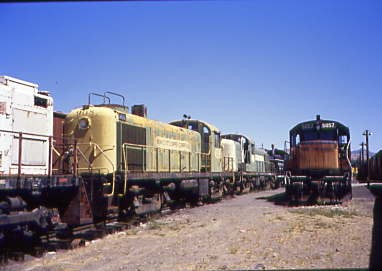
On the left is Kennecott Copper RS-3 2, nee American Smelting & Refining Company Garfield Smelter 2 built by American Locomotive Company in 1950; and on the right is Milwaukee Road U25B 5057 built by General Electric in 1965. It was part of a diesel engine instruction program at Webster Technical College in Sidney, Nebraska before being donated to the Feather River Rail Society in 1991.
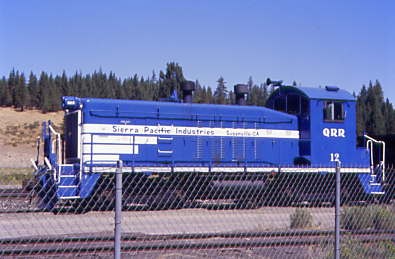
Quincy Railroad SW9 12, ex. Amador Central Railroad 12, exx. Chattahoochie Industrial 12, nee Arkansas & Louisana Missouri Railway 11, built by Electro-Motive Division in 1963.
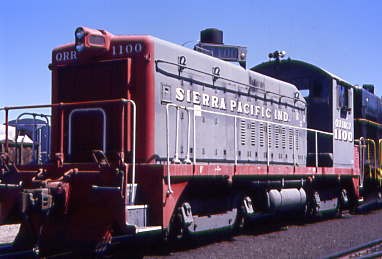
Quincy TR6 1100 built by Electro-Motive Division in 1950 built as EMD demonstrator 1600, then Southern Pacific 1600. It was used as a Sacramento Shop switcher - perhaps the only surviving TR6A.
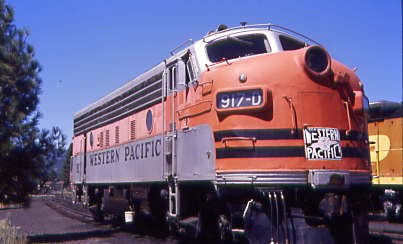
Western Pacific F7A 917-D built by Electro Motive Division in 1950. It was acquired in 2005 as part of a trade with the Bay Area Electric Railway Association at Rio Vista Junction.
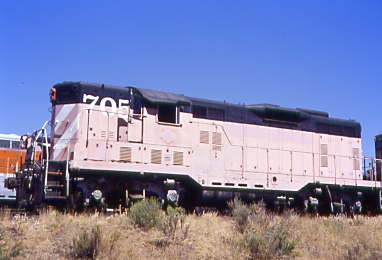
Western Pacific GP7 705 built by Electro Motive Division in 1952. 705 came to the Western Pacific Railroad Museum from Arizona where she spent several years working in the desert hauling freight for shortline "Arizona Central" after retirement from the Western Pacific. This explains the faded red paint. 705 was purchased by a group of FRRS members and brought "home" in 2005. Nicknamed "Mary Kay" due to its pink (faded red) paint, the 705 will be restored as time and money allow. For the time being, WP 705 is stored at the museum on display. Once mechanical restoration is completed, it will be pained the Perlman Green and Orange paint scheme.
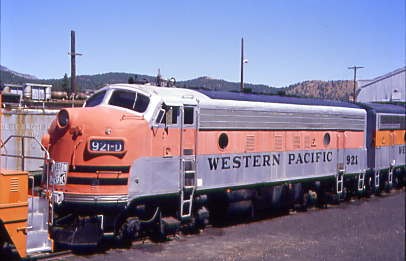
Western Pacific F7A 921-D built by Electro Motive Division in 1950.
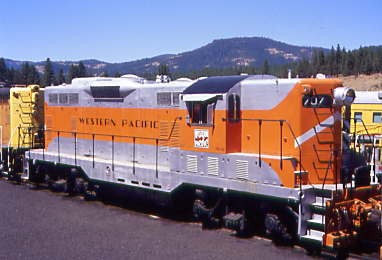
Western Pacific GP7 707 was built by Electro Motive Division of General Motors in 1952.
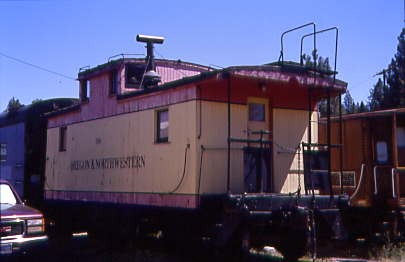
Oregon Northwestern cabosee 300 built by Norfolk & Western Railway in 1915. It was renumbered Norfolk & Western 18121, a later re-number had her as Norfolk & Western 518121. She was sold to the Oregon & Northwestern Railroad and l later purchased by Errol Spangler and placed on permanent loan to the Feather River Rail Society by Mr. Spangler and was later sold FRRS Board member Wayne Monger.

Quincy Railroad 44 ton switcher 3 built by General Electric in 1945. It relegated Alco 2-6-2T 2 to stand-by service when it arrived, but the steam engine did not leave until 1970, seeing occasional use on excursion trains. This engine has never been out of Plumas County since it was delivered to the Quincy in 1945.
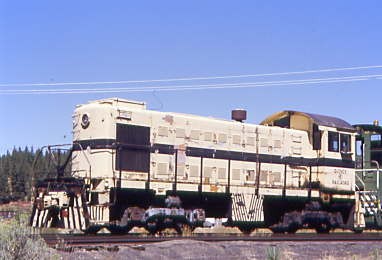
Quincy Railroad S1 4, nee Western Pacific 504, built by American Locomotive Company in 1942. It was sold to Sacramento Northern as their 405 in December 1967 and then to the Quincy Railroad in April 1973.
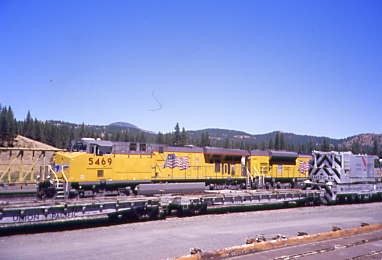
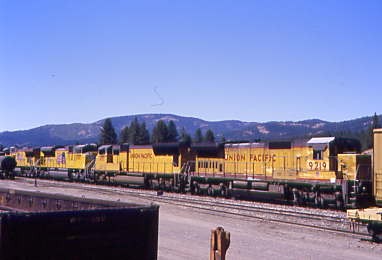
Union Pacific 5469 West left Portola during our visit.
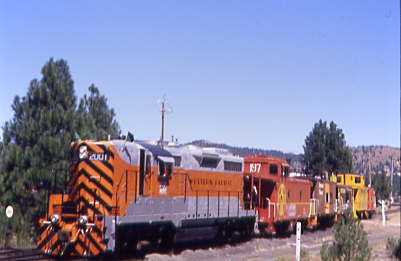
After I photographed the excursion train again, I rode it for a second time.
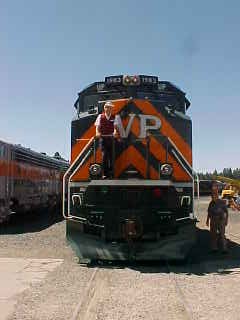
Bill Parks, our tour guide, on Union Pacific 1983.
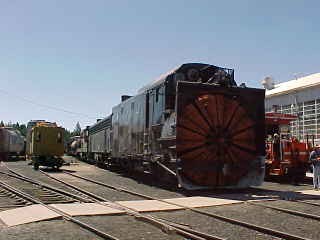
Southern Pacific rotary snowplough 208 built by Alco-Brooks in 1927. It was leased to Western Pacific and used at Keddie and the High Line after Western Pacific had retired their ploughs.
I returned to the bus which departed at 2:42 PM and I was back in Room 1711 by 3:40 PM. Later, I walked over to the Century 14 Theater to see "Sky High" which was excellent then returned to the Nugget for their "buffet dinner" which filled me up nicely.

The view from my room before I relaxed for the rest of the evening.
Sparks 8/27/2005After going for another light breakfast at the same counter, I checked on the westbound California Zephry, that at this point, was only an hour late then walked over to Victoria Square for some railroad displays.
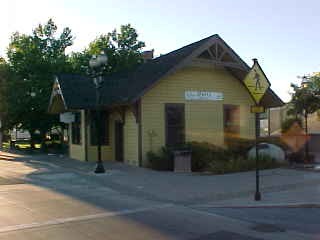
Southern Pacific replica station built in 1976.
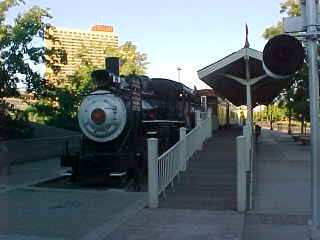
Southern Pacific narrow gauge 4-6-0 8, nee Nevada-California-Oregon 8 built by Baldwin in 1907. It was donated to the State of Nevada in 1955 and leased to the City of Sparks in 1986.
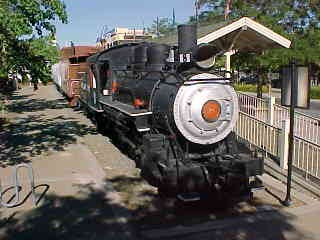
Standard gauge cars behind the steam engine. I returned to the room, checked the Weather Channel about Katrina and then was able to watch Jackie Chan in "Mr. Nice Guy". I then found out our train had lost even more time and about 9:20 AM, walked over to the yard to where the cars were parked.

A while later when we all aboard, the Union Pacific switch crew arrived to put our cars on the rear of the California Zephyr and for safety reasons, everyone had to detrain until our cars were attached.
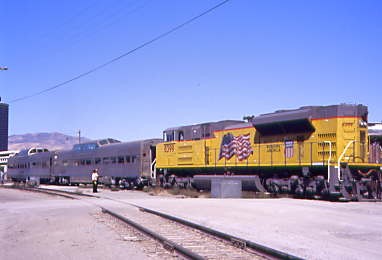
Union Pacific SD70ACe 8399 coupled on to our two private cars.
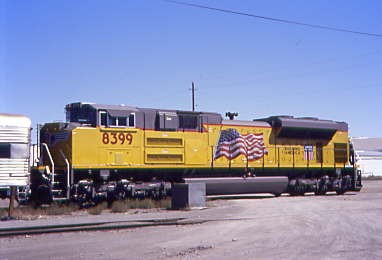
Union Pacific 8399 then pulled our cars to the east end of the Sparks Yard and waited for the Calfornia Zephyr to arrive.
California Zephyr 5 8/27/2005Our train arrived at 11:34 AM with P42DCs 197 and 202, baggage 1212, transition 39011, sleepers 32047 and 32074, diner 38024, lounge 33022, coaches 34091, 34072 and 31042, ExpressTrak 74032 and 74041. After "Silver Lariat" and "Plaza Santa Fe" were added, we all reboarded and departed at 11:56 AM {8:55 AM}, with me once again in the dome of "Plaza Santa Fe".
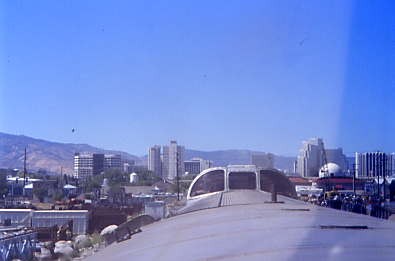
The California Zephyr rolled west into Reno.
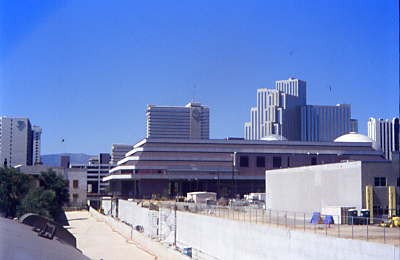
The Reno Trench was still under construction and when complete, it will take all rail traffic off the surface and put it down into the trench, thereby eliminating many grade crossings. We departed Reno at 12:16 PM {9:14 AM} and followed the Truckee River.

Travelling up the Truckee River Canyon as seen from the rear door of "Plaza Santa Fe".

Our journey along the canyon en route to Truckee, from which we departed at 1:18 PM {10:15 AM} on the way to Coldstream Canyon.
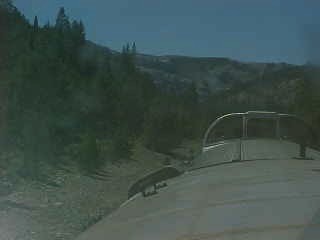
Climbing the grade towards the Summit Tunnel.
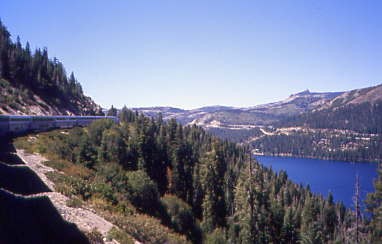
Below is Donner Lake.
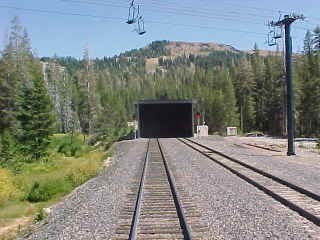
Exiting the Summit Tunnel, also known as the "Big Hole". We ran down to Norden and had to wait for an eastbound Union Pacific freight.
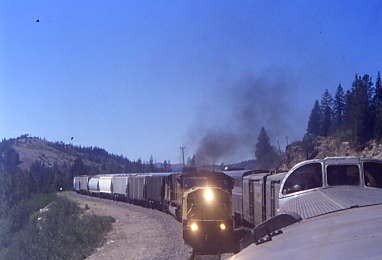
Here came Union Pacific 8051 East through Norden.
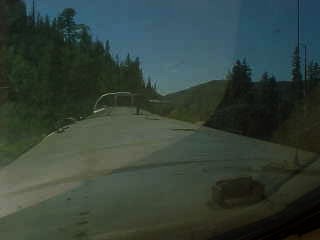
Rounding a curve below Soda Springs.
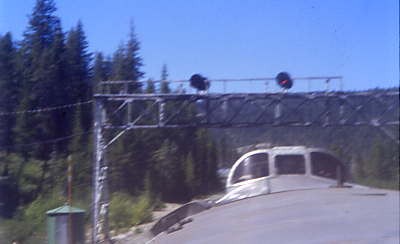
We passed under a signal bridge.
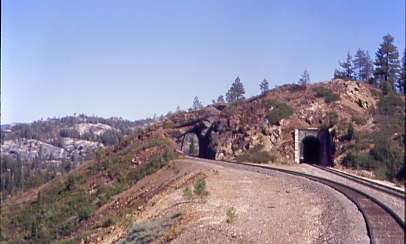
A pair of tunnels with one still in use above Yuba Gap. The bells were then chimed and I went into the Turquoise Room for lunch.
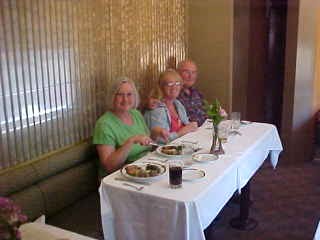
My tablemates for lunch, Leanne and Richard Curtis and Melissa Arnold.

A photograph of the author by Leanne. Bill Parks and his wife were also in the Turquoise Room and we had a good discussion. Lunch was Sliced Roast Tenderloin of Beef with a Bourbon Cream Sauce, which was excellent. Three eastbound Union Pacific freights passed us during our meal.
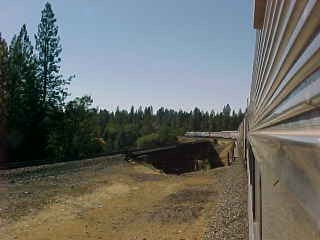
The California Zephyr crossed the Long Ravine Trestle then while waiting for dessert, we stopped at Colfax at 3:44 PM {12:26 PM}. Dessert was Chocolate Applesauce with Vanilla Ice Cream and Chocolate Sauce, also delicious. I returned to the Plaza dome for the journey down through the Sierra Foothills to the Sacramento Valley.
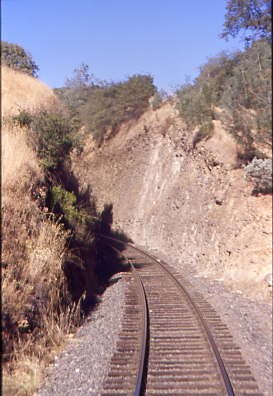
Later we exited the Bloomer Cut as we neared Rocklin then descending into the Sacramento Valley, you could see the Sutter Buttes, Downtown Sacramento and Mount Diablo on this very clear afternoon. We then stopped at Roseville at 5:15 PM {1:35 PM} and made our way to Sacramento.
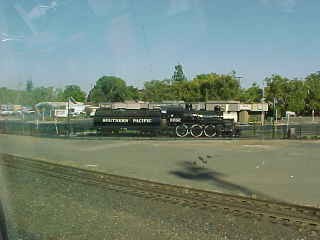
Southern Pacific 2-6-2 2252, nee Southern Pacific 1838 built by Cooke Locomotive Works in 1897. These locomotives started as freight helpers over the Donner Pass until they were relegated to secondary service by the arrival of larger power. In 1929, four of the class, including 2252, were modified as "fire trains" or "water trains" for service in the northern California mountains. During summer, the fire train locomotives were kept hot at all times and a crew was always on duty in case they were needed to attend a fire. Because of their importance in fighting lineside wildfires as well as protecting wooden show sheds, the fire train locomotives were amongst the last steam motive power retired by the Southern Pacific.
2252 was retired in 1956 and was donated to the City of Roseville the following year. It initially went on display in Placer Fairgrounds but in 2004, it was moved to its current location at the intersection of Atlantic Street and Vernon Street.
We passed the J.R. Davis Yard and continued to Sacramento, where everyone detraining had to find our luggage to be offloaded at the station. We curved west at Elvas Tower before arriving at Amtrak Sacramento station at 5:40 PM {2:15 PM} where I said goodbye to all my new friends, ending another excellent Trains Unlimited Tours excursion.
Sacramento 8/27/2005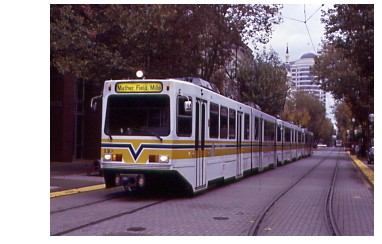
I retrieved my luggage and walked into the station to let my brother Bruce know I had arrived then walked over to K Street to wait for a trolley to Meadowview. After a ten minute wait, it arrived and took me south to Meadowview station, where Bruce met me to take me home to his house for the night.
Going Home 8/28/2005
I went to work with Bruce and learnt more about Hurricane Katrina on the radio then arrived at the station before 5:00 AM and I read USA Today and listened to tunes before going outside to wait for my train to be spotted.
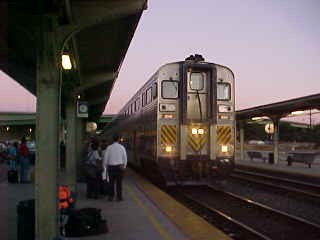
San Joaquin 702 ready to take me to Bakersfield, whose consist was cab car 8301 "Mount Whitney", café 8803 "San Gabriel Valley", coach 8007 "Russian River" and coach/baggage 8205 "Monterey Bay" with F59PHI 2010. We departed on time on a beautiful clear morning but lost twenty minutes on the way to Stockton on the Union Pacific. BNSF kept us on their mainline all the way to Bakersfield where I boarded the Thruway Bus to LAUPT, arriving there at 2:20 PM.
I missed Pacific Surfliner 578 so had to wait for Metrolink 684 to take me home. We left LAUPT at 2:50 PM and rolled the miles home to Santa Ana on time, ending another exciting rail adventure.
| RETURN TO THE MAIN PAGE |